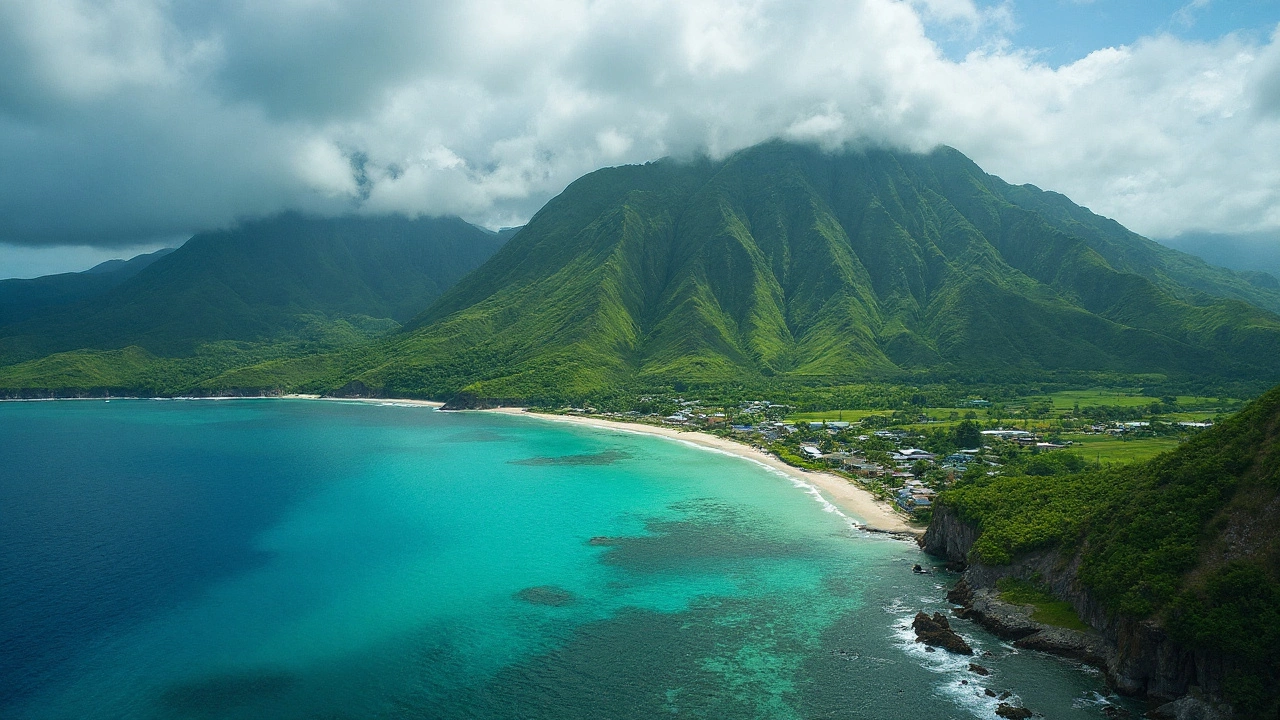Here’s a U.S. destination with no crowds, beaches you might have to yourself, and a national park south of the equator. That’s American Samoa, a five-island territory in the South Pacific where daily life still moves to the rhythm of Fa’a Samoa—the Samoan Way. It’s remote, yes. But for travelers who like wild coastlines, clear lagoons, and real cultural encounters, it’s one of the most rewarding trips you can take without leaving U.S. soil.
The territory stretches across Tutuila, Aunu’u, Ta’u, Ofu, and Olosega, with a population just big enough to keep things running and small enough that you’ll learn names quickly. The scenery swings from knife-edge ridgelines and rainforest to powdery beaches and coral gardens. Most visitors start in Tutuila, base in the harbor town of Pago Pago, and then push outward to the outer islands if flights and weather line up. When they do, you get the kind of solitude you can’t buy in busier parts of the Pacific.
Top Places and Experiences
1) National Park of American Samoa
Spread across Tutuila, Ofu, and Ta’u, the National Park protects montane rainforest, sea cliffs, and thriving reefs. It’s the only U.S. national park below the equator, and its land is leased from village families—so conservation happens hand-in-hand with tradition. Expect fruit bats swinging over canopy views, geckos on warm stone, and reef fish that look like someone turned up the saturation.
On Tutuila, the Mount ‘Alava Adventure Trail is the signature hike: stairs, ropes, and big views over the harbor. The Pola Island area frames a postcard of sea stacks and nesting seabirds. If you want something gentler, the Lower Sauma Ridge Trail offers a short, scenic workout. On Ta’u, the Tumu Mountain Trail cuts into dense green and cloud forest. Rangers can point you to quiet marine spots where you can float over corals without a crowd churning the water.
Practical tip: the park’s visitor center sits near Pago Pago. Pop in before you hike. Some trailheads cross village lands; ask permission if you’re unsure, and follow posted guidance about dress and access.
2) Pago Pago: Harbor, Hills, and a Working Capital
Pago Pago (pronounced “Pango Pango”) hugs one of the Pacific’s deepest natural harbors. This is the territory’s hub—part government town, part market town, and the best place to get your bearings. Grab a coffee in the morning, then ride the ridge road to lookouts under Rainmaker Mountain’s steep slopes. On market days around Fagatogo, you’ll find bunches of green bananas, breadfruit, and fresh fish on ice alongside colorful lavalava wraps.
Mount ‘Alava is the obvious day hike from Pago Pago, but you can also keep it simple: walk the waterfront, watch the aiga buses rumble by, and end the day with a plate of oka (Samoan ceviche) or palusami (taro leaves with coconut cream). For many travelers, the capital isn’t just a stopover—it’s where local life clicks into focus.
3) Ofu Beach: A Quiet Arc of Sand You’ll Never Forget
Ofu sits across a causeway from Olosega in the Manu’a Islands. Together, they offer what many call the best beach in the Pacific. Ofu Beach is a long curve of white sand with a backdrop of steep, jungled cliffs and reef flats so clear you can pick out sea cucumbers from the shore. Snorkeling here is like gliding through a glass bowl—parrotfish, butterflyfish, clams, and coral heads in pristine condition.
Getting to Ofu takes patience. Flights and boats run on limited schedules, sometimes only a few days per week and always subject to weather. That’s part of the magic: you won’t be competing with day-trippers. Plan to stay at least a couple of nights, bring cash, and pack what you need. In exchange, you get silence, stars, and mornings where you are the only footprints on the beach.
4) Fagatele Bay: Protected Reef, Big Payoff
Fagatele Bay sits within the National Marine Sanctuary of American Samoa, which protects several reef units around Tutuila. The bay is a natural bowl of turquoise surrounded by green. On calm days, the visibility can be outstanding, and the coral diversity is among the best in the territory. Turtles pass through. Small reef sharks patrol. The reef builds out into terraces and bommies that make snorkeling and diving both scenic and easy to navigate when conditions are right.
Access can involve steps and a short hike. Check local guidance on currents and swell before you jump in. It’s a sanctuary for a reason—take only photos, and skip reef walking. Your mask and good fins are your ticket to the show.
5) Village Life and Fa’a Samoa
The heart of a trip here isn’t just the scenery; it’s village time. Samoan culture is built around the aiga (extended family) and guided by matai (chiefs). Evenings often pause for sa—prayer and quiet—when roads can close and music fades. Sundays are for church and rest. If you’re invited to an ‘umu (earth oven) cooking, go. Watch taro and breadfruit steam under hot stones and banana leaves. If there’s siva (dance), the stories are in the hands and hips. Respect the protocols, and you’ll find the welcome is warm and genuine.
Etiquette matters. Dress modestly in villages (cover shoulders and knees). Ask before you cross village land or photograph people. If a rugby game kicks off on the green, cheer along, but keep alcohol tucked away unless your hosts say otherwise.
Bonus: Aunu’u for a Day
A short boat ride from Tutuila, Aunu’u is a small, photogenic island known for its wetlands, wave-bashed lava rock, and simple village rhythm. Trails lead to tide pools and views back toward Tutuila’s mountains. It’s a low-stress add-on that shows how each island has its own character even within a small territory.

How to Plan: Getting There, When to Go, and What to Expect
Getting There
Most visitors fly in via Honolulu or Samoa (Upolu Island, Apia). Schedules are limited and can change, so plan flights early and build in buffer time. Interisland hops to the Manu’a group (Ta’u, Ofu/Olosega) run a few days a week in good periods and may pause during maintenance or rough weather. Ferry options appear on and off and can be seasonal. Flexibility is not a bonus here—it’s a requirement.
Entry rules: U.S. citizens and U.S. nationals generally don’t need a visa for short stays but should carry proof of citizenship (a passport is the smoothest option). Travelers from other countries typically need an entry permit in advance. Everyone should have a return or onward ticket. Because the territory controls its own borders, don’t assume rules match the mainland; check the latest before you go.
Getting Around
- Aiga buses: Colorful, cheap, and social. Routes link villages along the main roads on Tutuila. Pay cash when you hop off.
- Taxis: Easy in and around Pago Pago; agree on the fare before you start.
- Car rental: Limited supply. Book ahead. Driving is on the right, roads can be narrow and potholed, and rain cuts visibility fast.
- Boats and small planes: Essential for reaching Aunu’u and the Manu’a Islands. Weather calls the shots.
When to Go
It’s tropical year-round. Expect warm, humid days, passing showers, and brighter weather after squalls. The drier stretch often runs June to September, but showers can hit any month. Humpback whales pass by roughly September to October, when you might spot blows and tail slaps from shore. Cyclone risk rises from about November through April; that’s also when heavy rain is more common.
Where to Stay
Options are modest but comfortable: small hotels and guesthouses on Tutuila, a couple of lodgings near key beaches on the outer islands, and family stays if arranged ahead through local contacts. Rooms can book out when flights are full, so secure beds as soon as you have tickets. On Ofu and Ta’u, bring snacks, sunscreen, and any special medicine—shops are basic and close early.
What It Costs
- Flights: The biggest expense. Prices swing with demand and schedules.
- Rooms: Midrange by Pacific standards; expect simple comforts over luxury.
- Food: Affordable local plates (try oka, sapasui, panikeke) and slightly pricier Western items in town. Cash helps in smaller villages.
- Activities: Hiking is free; guided cultural or boat trips add cost but support local families and conservation.
Food and Drink
Eat local. Fresh tuna and reef fish, taro and breadfruit, coconut in everything from palusami to desserts. Try oka with lime and coconut, a roadside plate of BBQ chicken with ulu (breadfruit), or hot panikeke (banana fritters). Kava (‘ava) ceremonies happen by invitation; if you’re welcomed in, follow your host’s lead.
Etiquette and Access
- Dress modestly in villages; swimwear is for the beach, not the road.
- Sa (evening prayer) means quiet. Pause your walk or music until it ends.
- Ask for permission before crossing village land or starting a trail near homes. The pulenu’u (village mayor) or a matai can guide you.
- Sundays are for church and rest. Many shops close; plan meals and travel accordingly.
Health and Safety
- Sun and sea: Use reef-safe sunscreen, a rash guard, and hydrate. Currents can be strong—ask locals before swimming.
- Reefs: Don’t touch coral, don’t feed fish, and avoid reef walking. Cuts get infected fast in the tropics.
- Weather: Squalls and cyclones happen. If a storm is forecast, follow local advice.
- Tsunami awareness: You’ll see evacuation routes. Know your uphill path; the 2009 tsunami is a living memory here.
- Medical care: There’s a hospital on Tutuila. For complex issues, evacuations go to Hawaii or Samoa. Travel insurance with medical evacuation is a smart buy.
Connectivity and Money
The currency is the U.S. dollar. ATMs are available on Tutuila; bring cash to outer islands. Mobile coverage is strongest around Pago Pago and along main roads; it thins in remote areas and across channels. Roaming can get pricey—check with your carrier or look for a local SIM if available. Wi‑Fi appears at hotels and a few cafes, but it’s not lightning fast.
Gear Checklist
- Lightweight rain jacket and quick-dry clothes
- Sturdy sandals or trail shoes for roots and mud
- Mask, snorkel, and fins you know fit
- Reef-safe sunscreen, hat, and sunglasses
- Dry bag for boat rides and squalls
- Small first-aid kit and any prescription meds
- Cash for buses, village shops, and tips
Sample 7-Day Outline
- Day 1: Arrive Pago Pago, stock up, sunset harbor walk.
- Day 2: National Park visitor center, Mount ‘Alava hike, dinner in town.
- Day 3: Aunu’u day trip—tide pools and village stroll—back to Tutuila.
- Day 4: Fagatele Bay snorkel (conditions permitting), market time in Fagatogo.
- Day 5: Fly or boat to Manu’a; settle in.
- Day 6: Ofu Beach snorkeling and reef flats, slow afternoon under the palms.
- Day 7: Morning swim, return to Tutuila, last-minute crafts, fly out.
Environmental Reality Check
Reefs here are among the Pacific’s best, but they face heat stress, storms, and runoff. The sanctuary and national park work with villages to restore corals and keep fishing sustainable. Your part is simple: use reef-safe sunscreen, pack out every scrap of trash, skip single-use plastics when you can, and buy local—your money keeps conservation practical for the families who steward these places.
Why It’s Different
Unlike resort-heavy islands, the territory hasn’t been reshaped for mass tourism. Buses run on island time. Schedules change. Sundays go quiet. That friction is also the charm: you’re stepping into a living culture, not a show staged for visitors. If you can meet the islands on their terms—patient, curious, and respectful—American Samoa will meet you with beaches you’ll talk about for years and a welcome that goes beyond a smile at check‑in.





